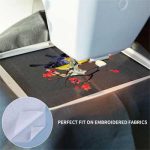Firming Things Up If you own an embroidery machine, chances are good you have a drawer full of various types of stabilizers needed for your embellishing. However, if you don’t have an embroidery machine, you may not think you need stabilizers—but think again! What is stabilizer? Simple answer—something to put behind or over fabric temporarily […]






